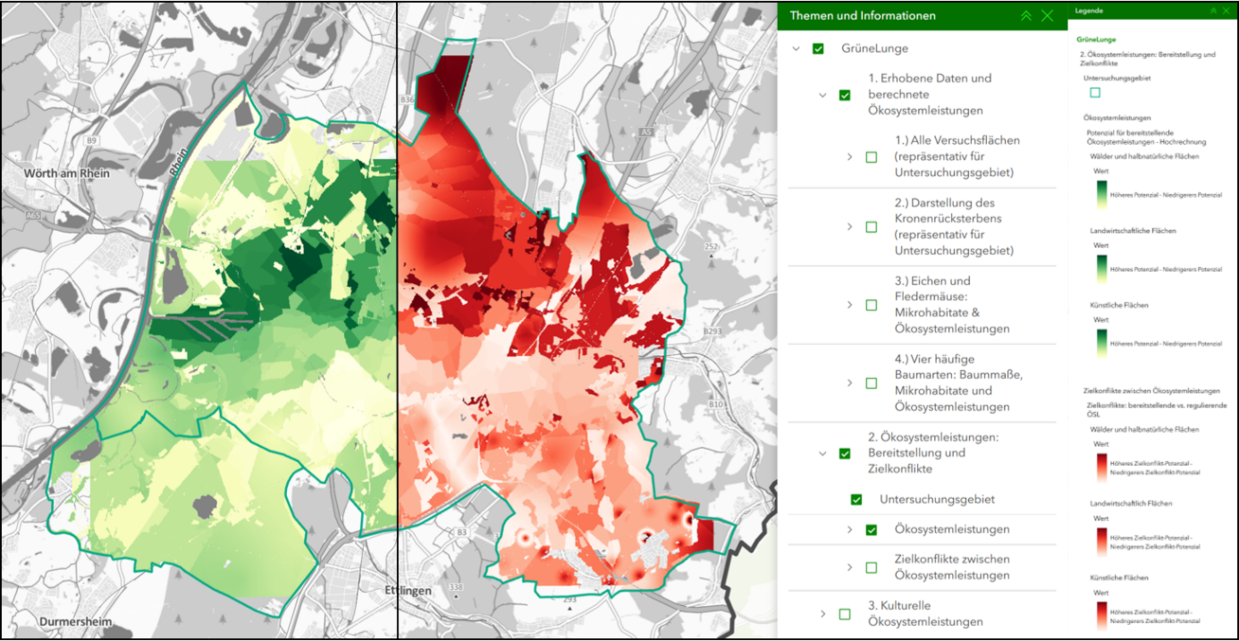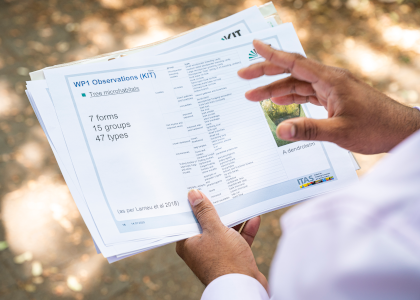Presentation of the project results in the geoportal

As part of the GrüneLunge 2.0 project, we have set up a geodatabase system to visualize and link all the data collected from the GrüneLunge 1.0 and GrüneLunge 2.0 projects. This data mainly includes information on regulating, providing, supporting and cultural ecosystem services, as well as on tree crown dieback. This database is intended to support the further development of urban tree management in the city of Karlsruhe and to enable regular monitoring of the ecosystem services provided by trees.
The geodatabase is provided by the City of Karlsruhe in the city's geoportal and can be accessed via the following link:
https://geoportal.karlsruhe.de/gruenelunge/
In consultation with the city of Karlsruhe, it was decided to divide the data into three main maps with respective sub-maps. The aim of this structure is to ensure the simplest possible user experience by only having to switch a few layers on or off to display the desired data records. The data was divided up thematically.
The first thematic map shows the data collected. It comprises four sub-maps: two with data from the main GrüneLunge dataset (representative for the urban areas of Karlsruhe and Rheinstetten) and two with datasets from final theses (non-representative for the urban area). The second thematic map contains projections for the entire urban area of Karlsruhe and Rheinstetten based on the research data and calculated using i-Tree Eco. The potential ecosystem services (ES) are shown in sub-maps, as well as possible trade-offs between the three categories of ES. The third thematic map shows the results of a survey on the perception of cultural ES among citizens from Karlsruhe and Rheinstetten. The figure above shows the provided ES (shown in green) and potential trade-offs between the categories of ES (in red).
The places that were perceived as particularly valuable are visualized by the color intensity in a heat map. Due to the large number of categories recorded, three central ones were highlighted (nature education, recreation and social relationships), supplemented by an overall representation that illustrates the overall perceived importance of the places.
The GrüneLunge project is based on the knowledge that green spaces, and trees in particular, are extremely important for the microclimate and air quality in the city. Improving urban microclimate and air quality is one of the most important regulating ecosystem services provided by urban trees. Conversely, urban trees are often stressed by urban conditions, which reduce their beneficial effects.
Therefore, in the first phase of the project, information was collected characterizing the climate on the one hand and tree characteristics in the city on the other hand. The data collected by KIT-ITAS from GrüneLunge 1.0 were used to quantify the regulating ecosystem services of urban forests. For this purpose, the United States Forest Service's i-tree-eco urban ecosystem services modeling software was used. It provided us with some estimates of the potential regulating ecosystem services of urban trees. However, it was not entirely accurate because many equations used in the i-tree-eco software to model regulating ecosystem services were generalized and not tailored to the urban site conditions in Karlsruhe and Rheinstetten. In a parallel project to GrüneLunge, KIT-IMK developed a process-oriented model (Tree4C) for estimating the regulating ecosystem services of individual urban trees.
Based on the data collected by GrüneLunge 1.0, we will use the Tree4C model to quantify the effects of urban trees on ambient temperature and air pollution in the cities of Karlsruhe and Rheinstetten. The dependence of these effects on weather and water availability will be explicitly considered, and their conservation will be investigated with respect to sensitivity and climate scenarios. Based on this, the potential influence of urban management through maintenance, irrigation, and species selection will be elaborated. To achieve this goal, the Tree4C model will be used to represent the environmental impacts of trees as a function of dimension, location, and tree species-specific sensitivity to drought stress. This model will be parameterized and initialized for significant urban trees and their locations based on the Karlsruhe urban tree cadastre and additional measurements from both project phases. Further investigation results, such as the determination of temperature differences in the vicinity of green spaces, will be used to evaluate the modeling. The subproject thus builds on previous work and goes beyond specific measurement locations and times to analyze the effects of different, but expected future, extreme weather events (heat waves) and possibilities for countermeasures (irrigation).
Point-based system to evaluate ecosystem services from urban and peri-urban forests
Urban and peri-urban forests, including individual city trees in streets, parks, or gardens, significantly contribute to human health and well-being by providing essential ecosystem services. These services include climate change mitigation through CO2 sequestration, habitat provision for urban wildlife, opportunities for recreation and relaxation, and the enhancement of urban landscapes. These services impact human health directly or indirectly. Therefore, city trees not only increase urban resilience but also improve the well-being of city residents.
As part of the GrüneLunge 1.0 project, a concept was developed to assess the ecosystem services of urban trees using a point-based system. This system is based on field data collected during the project. The goal of the subsequent project GrüneLunge 2.0 was to further develop this point-based system for a comprehensive assessment and standardization of the various ecosystem services provided by urban trees, including their regulatory, supporting, cultural, and provisioning functions. Additionally, the legal framework for implementing the concept was analyzed. Furthermore, opportunities and challenges for the concept's implementation were identified and examined through workshops and interviews with various stakeholders, including municipal offices such as the Arboriculture Department, Forestry Office, and Environmental Agency.
The Ecosystem Service (ES) point-based system is intended to serve two main objectives. Firstly, it aims to enable the valuation of urban trees based on their diverse ecosystem services while highlighting the societal importance of these services. Secondly, this assessment aims to increase the recognition of these services so that they are appropriately considered in private and public decision-making.
.png)
